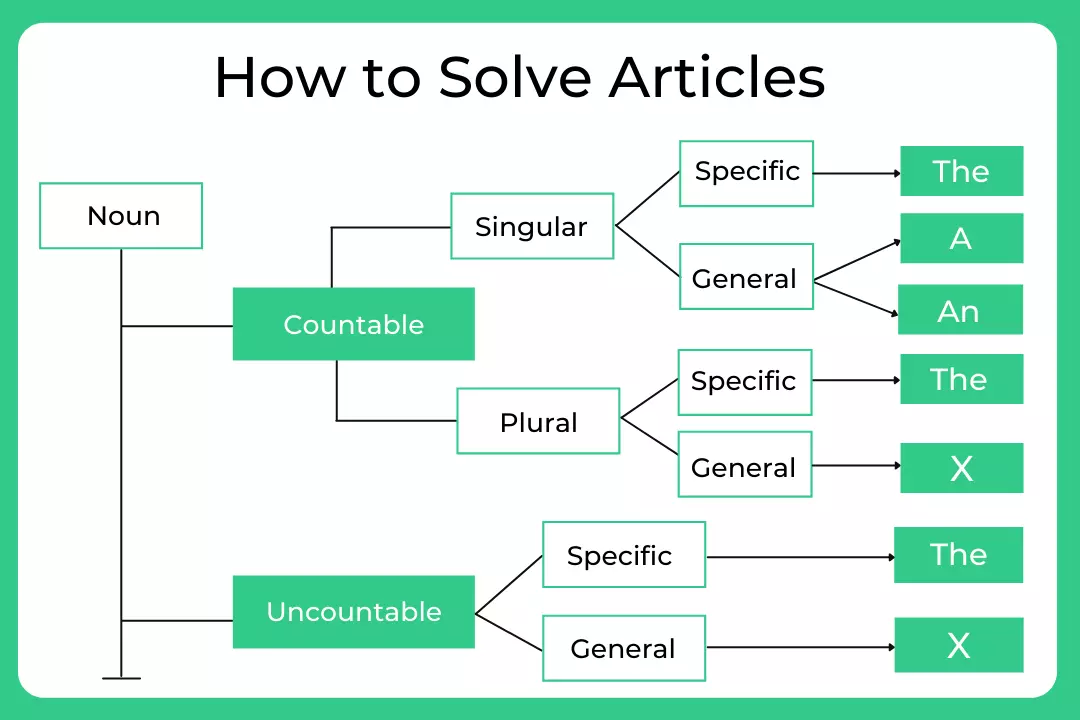Verbal Menu
- Basic Grammar
- Speech and Voices
- Tenses
- Articles
- Tenses and Articles
- Idioms and Phrases
- Subject Verb Agreement
- Prepositions and Conjunction
- Selecting Words
- Relative Pronoun
- Sentence Completion
- Sentence Ordering
- Contextual Vocabulary
- Jumbled Sentence
- Sentence Formation
- Error Identification
- Sentence Improvement and Construction
- Cloze Test
- Fill in the blanks
- Paragraph Ordering
- Para Jumbles
- Synonyms and Antonyms
- Synonyms
- Antonyms
- Reading Comprehension
- Get Off-campus Drive Updates
- Get Hiring Updates
- Contact US
PREPINSTA PRIME
How To Solve Articles Questions Quickly
How To Solve Quickly Articles Questions:
Definition:
Articles in English grammar are used to embrace a noun and determine whether it is countable or non-countable. Articles are also used to refer to nouns in both writing and speaking. There are three articles known in English grammar – A, An, The.
It is vital to know the rules and tricks to use while answering any question related to article. Let’s get a quick read about the three simple rules relating to definite (the) and indefinite articles (a, an) and how to solve articles questions quickly –

The Three Rules Used To Solve Articles Questions Quickly
Rule 1
Specific Identity unknown:
In a situation where specific identity is unknown to the reader we use the indefinite articles ‘a’ and ‘an’. As the rules claim, we should ‘A’ before any consonant noun and ‘An’ before a vowel noun (a, e, i, o, u).
- We use ‘a’ or ‘an’ to address any general participant of a group.
- A dog is faithful
- That woman is a doctor
- We went to look for an apartment.
- We use indefinite article to address any number. ( only one in count)
- I have a bat and two balls.
- I ate an apple and an orange
- We use ‘a’ before a consonant or ‘an’ before a vowel (a, e, i, o, u).
- A car
- An owl
- A pen
- An island
- A car
- We use ‘a’ or ‘an’ before any adjective while describing a noun.
- An angry girl
- A beautiful picture
- An orange dress
- A horrifying incident
- We use ‘some’ when we address the plural form of a noun to replace indefinite articles. Using ‘some’ means to talk about a limited or unspecified amount of a noun. However, this should always be more than one.
- I want to drink some water (uncountable)
- She got me some pens from her shop (countable)
- I want to drink some water (uncountable)
Rule #2 –
Specific identity known
As the name suggests, we use the definite article ‘the’ to address any noun irrespective of its count or number (singular, plural) that is known or specific to the reader.
- We use ‘the’ to talk about any noun whose specifications are already known.
- I saw a strange animal yesterday. It turns out that the animal was from some foreign land.
- We have a new girl in the class. She is the girl from my martial arts class.
- We put ‘the’ to use when in a sentence, the supporting adjective, phrase or clause tries to restrict the identity of the noun.
- The girl from my college scored the highest in her SATs.
- I am grateful for the advice that you gave.
- Thank you for inviting me to the party tonight.
- To emphasize on the uniqueness of a thing or place or person, we use ‘the’.
- The Law of Inertia is Newton’s first law.
- The Taj Mahal is one among the seven wonders of the world
- The United States of America is a beautiful country
Rule #3
Everything general among all.
- When we talk about a noun that is general or common irrespective of its count or plurality, we use no article (definite or indefinite) to address it.
- Butterflies are beautiful insects (all butterflies are beautiful)
- She kept asking me for advice. (this can be any advice in general. )
- I love ice creams and chocolates ( I love all ice creams and chocolates)
Prime Course Trailer
Related Banners
Get PrepInsta Prime & get Access to all 200+ courses offered by PrepInsta in One Subscription
Check out some general questions on articles:
Type I ( Fill in the blank)
Question 1.
Complete the sentence with a suitable article:
They normally spend their vacations in __ mountains.
A. A
B. An
C. The
D. No article
Correct Answer: C
Explanation: “Mountains” is a countable noun, therefore, “the” is the right choice.
Question 2.
Complete the sentence with a suitable article:
She knows how to drive __ car.
A. a
B. The
C. An
D. No article
Correct Option: A
Explanation: “Car” is a common noun and they are always singular, therefore, the article “a” is the most suitable.
Type II (Replace the Underlined Word)
Question 3.
Choose the correct article for the underlined word:
He has been a good learner since school days.
A. An
B. The
C. a
D. No change
Correct Answer: D
Explanation: “He” is singular, hence “a” is the right choice and requires no change.
Question 4.
Choose the correct article for the underlined word:
We went to a restaurant where we always go.
A. A
B. The
C. An
D. No change
Correct Answer: B
Explanation: “The” resembles a particular place the person is talking about. “A” cannot be used as it will determine any random restaurant.
Type III ( Error Identification)
Question 5.
Identify errors in the below sentence:
New Jersey has a ideal climate.
A. Has
B. A Ideal
C. No error
Correct Answer: B
Explanation: The word “ideal” starts with a vowel i.e. “i” where “an” should be used instead of “a.”
Question 6.
Identify errors in the below sentence:
He was driving a SUV.
A. Was Driving
B. A SUV
C. No change
Correct Answer: B
Explanation: “S” starts with “es” sound and makes a vowel sound i.e. “e”, hence, “a SUV” is the error.
Also Check Out
Get over 200+ course One Subscription
Courses like AI/ML, Cloud Computing, Ethical Hacking, C, C++, Java, Python, DSA (All Languages), Competitive Coding (All Languages), TCS, Infosys, Wipro, Amazon, DBMS, SQL and others
- Basic Grammar – Questions | Rules | How to Solve Quickly | Tricks & Shortcuts
- Speech and Voices – Questions | Rules | How to Solve Quickly | Tricks & Shortcuts
- Tenses – Questions | Rules | How to Solve Quickly | Tricks & Shortcuts
- Tenses and Articles – Questions | Rules | How to Solve Quickly | Tricks & Shortcuts
- Idioms and Phrases – Questions | Rules | How to Solve Quickly | Tricks & Shortcuts
- Subject Verb Agreement – Questions | Rules | How to Solve Quickly | Tricks & Shortcuts
- Prepositions and Conjunction – Questions | Rules | How to Solve Quickly | Tricks & Shortcuts
- Selecting Words – Questions | Rules | How to Solve Quickly | Tricks & Shortcuts
- Relative Pronoun – Questions | Rules | How to Solve Quickly | Tricks & Shortcuts
- Sentence Completion- Questions | Rules | How to Solve Quickly | Tricks & Shortcuts
- Basic Grammar – Questions |
Rules |
How to Solve Quickly |
Tricks & Shortcuts - Speech and Voices – Questions |
Rules |
How to Solve Quickly |
Tricks & Shortcuts - Tenses – Questions |
Rules |
How to Solve Quickly |
Tricks & Shortcuts - Tenses and Articles – Questions |
Rules |
How to Solve Quickly |
Tricks & Shortcuts - Idioms and Phrases – Questions |
Rules |
How to Solve Quickly |
Tricks & Shortcuts - Subject Verb Agreement –
Questions |
Rules |
How to Solve Quickly |
Tricks & Shortcuts - Prepositions and Conjunction –
Questions |
Rules |
How to Solve Quickly |
Tricks & Shortcuts - Selecting Words – Questions |
Rules |
How to Solve Quickly |
Tricks & Shortcuts - Relative Pronoun – Questions |
Rules |
How to Solve Quickly |
Tricks & Shortcuts - Sentence Completion- Questions |
Rules |
How to Solve Quickly |
Tricks & Shortcuts

 Apply For Jobs
Apply For Jobs Get Hiring Updates
Get Hiring Updates




Login/Signup to comment